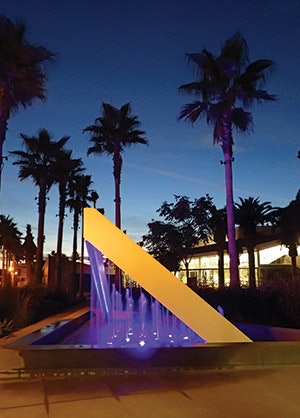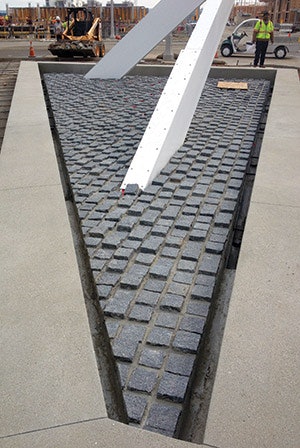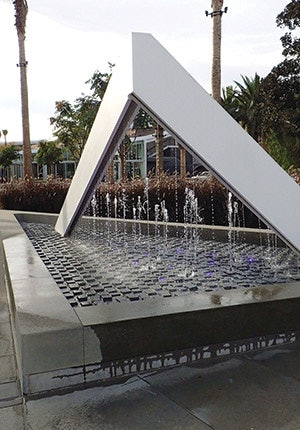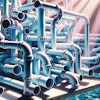 Photos by Mark Holden Photos by Mark Holden |
 Photos by Mark Holden Photos by Mark Holden |
 Photos by Mark Holden Photos by Mark Holden |
 Photos by Mark Holden Photos by Mark Holden |
Aquatic architect Mark Holden is no stranger to finding creative solutions to tricky construction and design problems. Case in point, a recently completed fountain in Playa Vista, Calif., prompted Holden and company to turn to a type of fiberglass-reinforced polymer as a steel substitute.
The aquatics design and construction industry is not particularly receptive to new materials. That's especially true when alternatives are used to replace time-tested materials such as concrete, steel and other construction staples.
The irony is that if you look at the history of pool construction, the industry has been largely defined by technical innovations. Prime examples include the use of pneumatically applied concrete, i.e. gunite and shotcrete in the early and mid 20th century and later, the eventual widespread acceptance of PVC plumbing.
It's hard to imagine our industry without those materials, but there was a time when the advent of those products and processes dramatically challenged the status quo. These days we see similar product evolutions in the use of variable speed pumps and LED lighting. Both were recently considered exotic but now are far more commonplace.
What many in our industry fail to see, or at least acknowledge, is that there now exists a range of options that in many cases can expand creative possibilities, save time and effort and ultimately generate superior results. In the project described here, we turned to a type of polymer material that we believe holds tremendous potential as a replacement for steel across a wide range of applications.
A High Profile
This scenario centers on an unusual water feature in a development in the city of Playa Vista, Calif.
Situated along the coast between Santa Monica and Venice, Playa Vista is the setting for a cutting edge, high-density community of upwardly mobile professional Los Angelinos and growing tech businesses. The centerpiece of the newly developed city is the Runway Community Center and Park, which houses a truly unique water feature that reflects the contemporary ethos of the community with a stark modernist design. Amazingly, for all the high-tech modernity of the community, the feature almost did not get built due to material and permitting constraints.
After the conceptual designers generated the conceptual sketches, our firm, Holdenwater, led a team of engineers, fabricators and artisans to use some highly unconventional techniques and materials in implementing the radical design ideas. At the heart of that effort was a material that in many applications is replacing steel.
Material Issues
Our first hurdle was that the original design called for a steel I-beam system to make up the signature V-shaped portion of the feature. From the very start, we had serious reservations because experience has taught us that steel and water typically do not work well together due to corrosion issues. In this case, we were tasked with building a large sculptural component that would be exposed constantly to both the corrosive effects of water and the salty air wafting in from the ocean.
Our material of choice for this scenario was a pultruded fiberglass resin, or FRP, instead of steel beams. The material has been around for years in a variety of formulations across a range of demanding applications. For example, FRP is routinely used in cell phone towers due to its nonconductive properties and resistance to corrosion. It's also fire resistant and almost completely immune to damager from harsh chemicals.
For these reasons, FRP is also perfect for aquatic applications. Because it doesn't conduct electriciy, it requires no bonding; it's far lighter than steel and far more easily modified on site. The raw material costs roughly the same as steel, but with the greater workability and relative ease of installation, the net savings are considerable in many situations.
In many ways, the reasons one would use FRP compared to steel is the same reason we use PVC instead of galvanized metallic plumbing. (It's interesting to think there was a time when some builders resisted changing to PVC.)
FRP's deflection is 10 times that of structural steel, meaning when under force it flexes about tenfold compared to steel. In this case, however, that physical characteristic amounted to only a fraction of an inch over the length of the beams we were using on this project and ultimately posed no issue.
On top of all that, this V-shaped structure also needed to be bright white according to the design.
We were able to gel-coat the FRP white as a sailboat using the same process. We could have powder-coated the steel to achieve the white "color," but experience has taught us the finish wouldn't last.
The bottom line was that had we used steel, we literally would not have been able to execute the design in any fashion that would last. As it is, the final result is a corrosion resistant, gigantic flying V.
Structural Issues
Although we cleared the initial hurdles simply by selecting an alternative material, the structure still needed some way to stabilize itself in the ground to keep from tipping over. Because the V was cantilevered up into the air on an extreme angle, there needed to be a foundation that could anchor the beams in a manner that would prevent them from ripping free from the feature basin.
The solution: a very large counterweight footing was designed by engineers to create a base for the beams. The toughest dilemma was how to get the beams in the concrete footing while being able to pour the concrete itself.
The creative solution was to make two FRP sleeves that would be set into the first pour of the feature basin's concrete footing. Then, the rest of the basin would be poured. And finally, the beams would be slipped into the sleeves. Easier said that done. The beams weighed several tons each and needed cranes and rigging to align in their eventual configuration. Again, had we tried this with steel I-beams, that effort would have required even greater expense, lifting power, time and effort.
Because the beams are different lengths set at different angles, we had to fabricate a custom cap piece designed to link the two beam tips together. While that process may seem obvious and relatively simple, truth told there were many months spent scratching foreheads to conceptualize these engineering feats.
Water Issues
Finally, there was no way to get the streams of water to fall evenly from the V by using pre-manufactured fountain parts. The ingenious solution crafted by my colleague Jeff Freeman was to borrow from the simple concept of an old plastic ice cube tray.
When filling such a tray from the faucet in the kitchen sink, we only need to add water to the top of the tray and let the flow transmit from cell to cell in the tray and eventually running the excess into the sink. Using this model for the large V, water is brought to the top of each length of the V and allowed to cascade down their interior over a series of small 9-inch baffles, which are akin to the cells in the ice cube tray.
The result is that there is an identical depth of water in each cell of the tray and thus puts the same amount of head pressure on the nozzles that are mounted to the bottom of each cell. This creates a uniform performance for the length of the V instead of having a lack of harmony in the fall of water.
Public Issues
For liability reasons, we did not want any standing water in the feature basin. A remote surge tank was designed and installed to keep the bulk of the water out of reach. To reduce the chance of children playing in the somewhat dry basin, a series of small square granite cobbles were installed to mitigate skateboarding inside the feature.
Also, the park itself did not have any allowable locations for equipment to be house in it. So the Community Center building was designated as the home for the mechanical electrical plumbing package that was needed to make the feature operate. The closest room in the building was over two hundred feet away from the feature basin and crossed a property line.
This presented another massive issue in permitting this feature through the Los Angeles County Health and City Building departments. There was no precedence for this since the utilities and mechanics were on one property while the structure and public interface occurred hundreds of feet away in the nearby park. Permitting took over six months in total, which was another unforeseen event in the lifespan of design and construction.
Now that it's finished, the feature serves as perfect visual keynote to the high-flown setting. Passersby will never know how making it happen required heavy doses of creative thinking and the use of a material that someday might replace most or all metal components used in everyday pools and spas.
A Careful Caveat
By way of experience, such as the scenario described in this discussion, I've become an enthusiastic proponent of FRP material. As mentioned in the adjoining text, the lightweight, resistance to corrosion and its non-conductive properties make it a great choice for all sorts of aquatic applications.
For all of those benefits, however, you have to be sure that the material you select is suited to the specific application. When you study the world of FRP products, it's immediately apparent that there are many different versions and there's no such thing as a one-size-fits-all type of FRP.
For example, our firm recently completed a large fountain project for a local medical campus. We purchased a sheet form of FRP that we were led to believe would be perfect for constructing the subgrade equipment vault. When the material arrived we could tell right away it wasn't a good fit, due largely to air gaps and other structural issues.
Just as is true of so many other elements of aquatic design and construction, you have to do your homework to make sure the material you purchase will perform up to spec for the given design.
Comments or thoughts on this article? Please e-mail [email protected].






































